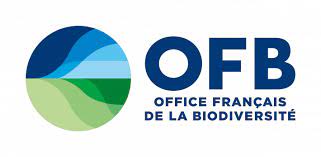SPECTRA PROJECT
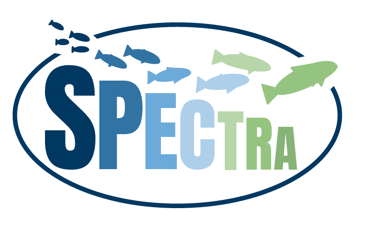
The SPECTRA project aim to quantify the impacts of global change on the freshwater systems in France. The project also proposes the size spectra as a robust bioindicator tool to evaluate the ecological health of freshwater habitats under the EU Water Framework Directive (WFD, 2000/60/EC). It combines a multidisciplinary research from experimental (mesocosms), empirical (data-driven) to theoretical (simulations) approaches. SPECTRA is funded by the French Office of the Biodiversity (OFB) with collaboration of the Laboratoire Évolution et Diversité Biologique (EDB) at the Paul Sabatier University and the French National Centre for Scientific Research (CNRS).
What is the size spectrum?
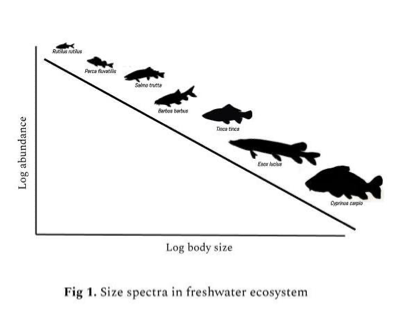
Size spectra simply describe the negative relationship of the numerical abundance (or biomass) of organisms and the body size (Fig 1).It provides a powerful basis to characterize ecological systems at different biological scales from populations to community structures. A main element of the size spectra is the body size (either body mass or length), a key trait in ecology that integrates many behavioral, ecological and biological information of any organism. Moreover, the size spectra have been linked to ecosystem functions due to the interplay between body size, energy fluxes and temperature. For applied research, the tool has been proposed as one of the main indicators in marine ecosystems to evaluate anthropogenic impacts such as overfishing or habitat degradation. Less is done, however, in freshwater systems despite that numerous publications have found predictable changes of the size spectra along environmental gradients. Thus, the size-spectra parameters can be used in freshwater systems to evaluate the ecological health of freshwater habitats, enhance the management practices of stocking and assess the overall effects of global change on the ecosystem functioning.
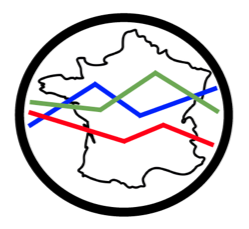
MAIN OBJECTIVES
Spatiotemporal dynamics of the fish size spectra: investigating the effects of anthropogenic, biotic and abiotic factors on the fish assemblage size structure
The objective is to assess the causes of variation of the fish size spectra in lakes and streams and identify which are the main drivers responsible of that variation. The objective would also allow to set the basis for the development of the size spectra as a bioindicator metric after controlling for the environmental factors.
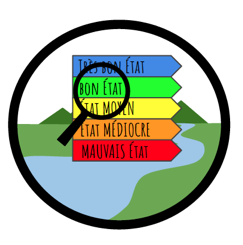
Understand and identify the determinants of size spectra variability and compare this approach to currently operational bioindicators
This objective will aim to understand and test the responses of the size-abundance relationship to anthropogenic and climatic pressures. It will also analyze the correlation between the « size spectrum » approach and the bioindicators currently used within the framework of the WFD. This will make it possible to establish the complementarity of approaches and to define whether the size-abundance relationship can become a more effective and operational bioindicator.
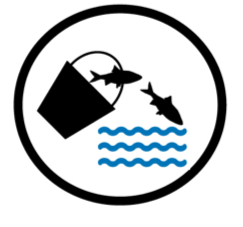
Investigating the effects of fish stocking practices on the fish assemblage size structure.
This objective will aim to quantifythe effect of different stocking practices on fish communities within waterbodies, from the response of the indicator which is the slope of the sizespectrum, but also the response of the intercept. To reach this, a simulation approach will be implemented with various scenarios of intensity of practices.

Linking size spectra and ecosystem functioning and how it is modulated by global-change drivers.
The goal is to evaluate the concerns of global change (i.e. temperature and eutrophication) and its effects on freshwater ecosystems. An ecosystem-based approach will be used to address these effects by integrating multiple trophic levels in a mesocosm experiment and assess how the environment (bottom-up) and predation (top-down) affect community structure (Size spectrum) and what the consequences are for energy flows within the ecosystem.

PROJECT MEMBERS
Julien CUCHEROUSSET (co-PI)
Gaël GRENOUILLET (co-PI)
Ignasi ARRANZ-URGELL (post-doctorate)
Marie GIMENEZ (PhD student)
Valentin MARIN (PhD student)
PUBLICATIONS
– Cucherousset J., Lassus R., Riepe C., Millet P., Santoul F., Arlinghaus R. & Buoro M. 2021. Quantitative estimates of freshwater fish stocking practices by recreational angling clubs in France. Fisheries Management and Ecology. 28:295–304.
– Marin V., Arranz I., Grenouillet G. & Cucherousset J. 2023. Fish size spectrum as a complementary biomonitoring approach of freshwater ecosystems. Ecological Indicators. 146: 109833.
– Gimenez M., Villéger S., Grenouillet G., & Cucherousset J. (2023). Stocking practices shape the taxonomic and functional diversity of fish communities in gravel pit lakes. Fisheries Management and Ecology. 00, 1–12.
– Arranz I., Grenouillet G. & Cucherousset. J. 2023. Biological invasions and eutrophication reshape the spatial patterns of stream fish size spectra in France. Diversity and Distribution. 29: 590-597.
FUNDING
